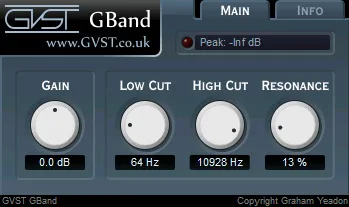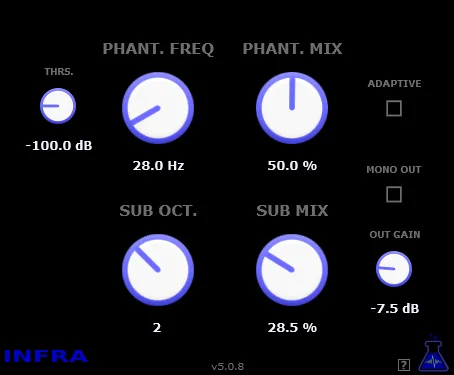GBand by GVST: A Unique Perspective on Resonant Bandpass Filtering
In the world of sound design and music production, filters are among the most important tools for shaping the timbre and dynamics of sound. They allow you to not only adjust the frequency balance, but also to create unique effects that add character and depth to your tracks. Among the variety of filter plugins, GBand by GVST holds a special place – a tool that offers a fresh and intuitive approach to working with a resonant bandpass filter.
GVST is known for its simple but effective plugins, and GBand is no exception. This plugin is the perfect example of GVST’s philosophy: to provide musicians and sound engineers with tools that work reliably and allow them to focus on creativity, not the complexities of the interface.
What is GBand and How Does it Work?
GBand is positioned as a resonant bandpass filter. Its main purpose is to pass a sound signal within a certain frequency range, simultaneously attenuating or completely removing frequencies below and above this range. The “resonance” aspect means that the filter can add a peak or emphasis on frequencies near the boundaries of the passband, making them more pronounced.
Difference from Traditional Filters
Most standard bandpass filters require the user to determine the center frequency (“node”) and adjust the Q parameter, which controls the width of the passband. This method is effective and widely used, but can sometimes seem less direct for quickly shaping the desired frequency curve.
GBand, however, uses a completely different, extremely intuitive architecture. It actually consists of a serial connection of two classic filter types:
- Low-Cut Filter: This component is responsible for cutting off all frequencies below your set cutoff frequency. The higher you set this limit, the more low frequencies will be removed.
- High-Cut Filter: This component, located after the low-cut filter in the signal chain, is responsible for cutting off all frequencies above your set cutoff frequency. The lower you set this limit, the more high frequencies will be removed.
Thus, the passband in GBand is formed naturally by the intersection of the operating zones of these two filters. Everything that is not cut off by the low-cut filter AND not cut off by the high-cut filter passes through the plugin. This is analogous to taking the separate GLow (low-cut filter from GVST) and GHi (high-cut filter from GVST) plugins and connecting them in series in an effects chain. This “composite” design makes the process of setting up the passband extremely clear and intuitive. You literally “cut off” the unwanted frequencies from both ends of the spectrum, leaving only the desired range.
Advantages of the Intuitive Approach and Application of GBand
The intuitiveness of the setup is a key advantage of GBand. Instead of thinking about the center frequency and Q, you simply decide which low and high frequencies you no longer need in the signal. This approach often proves to be faster and more effective, especially for tasks such as cleaning up a mix or quickly shaping the timbre.
GBand is a versatile tool and can be applied in many scenarios:
- Cleaning Up Tracks: Easily remove unwanted low-frequency hum, stage noise, or high-frequency hiss that can interfere with the clarity of the mix.
- Shaping the Timbre of Instruments: Give guitars, vocals, synthesizers, or other instruments the desired character by highlighting their main frequency band.
- Creating Special Effects: Use GBand to simulate the sound of a phone, radio, or other “cut-off” sounds by experimenting with narrow passbands.
- Dynamic Filtering: Automate the parameters of the low-cut and high-cut filters to create a “wah-wah” effect or other mobile tonal changes.
GVST GBand is not just a filter; it is a tool that simplifies working with sound, making the process of shaping the frequency response more accessible and creative. With support for VST formats on Windows (32 and 64 bit), macOS and Linux platforms, it is easily integrated into most modern DAWs. Try GBand if you are looking for an effective, intuitive, and flexible resonant bandpass filter for your music projects.



